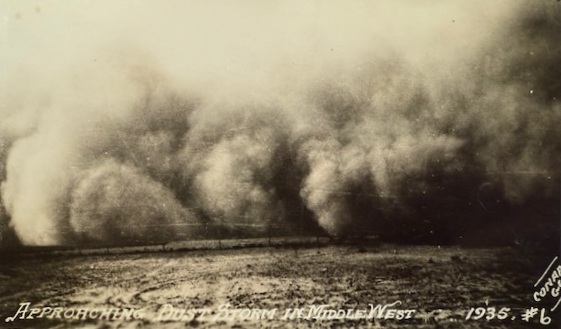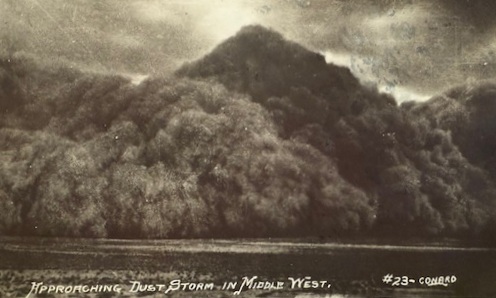This story about a 1930s dirt storm was written by the late Cora Rardon Holt and appeared in Volume II of the History of Kearny County.
I woke up one Tuesday morning and the smell which confronted me told me what to expect. A musty odor, that was disgustingly familiar, was the immediate explanation for the dim, strangely-colored half-light, that would be with us for some time. Outside the wind was howling and I knew we were having another duster. What I didn’t know was that it would be Friday morning before the air would again be clean and pure.
Sitting up in bed to turn on the light, I noticed the white print of my head on the pillowcase – everywhere else it had taken on a gray-brown color. Everything in the room was covered with a layer of tan silt. The curtains looked like they had been dipped in it. My bedroom slippers had to be emptied before I could put my feet into them. I had forgotten to turn them upside down the night before, a precautionary measure I had learned from past experience.
We lived in a sturdily-built stucco house with a living room extending the length of one side – 30 feet. As I came into this room, the light at the opposite end glowed like a fuzzy ball suspended in a thick haze, which made everything appear indistinct and far away. I looked down at the window sill, which was filling up with dirt, and a tiny landslide started and trickled down to the floor. Outside the window there seemed to be a wall; visibility was zero. This wall enveloped us as if we were contained in a capsule and, for days, changed only in color. If it took on a reddish-brown hue, we guessed New Mexico was going over; if it lightened to a dirty white, it might be Oklahoma; but always it would be black again, just like night.
Time hung heavy on our hands as the day progressed and eating posed a real problem. We learned to either gulp something like cereal and milk quickly under a newspaper tent, or to take our plates to the stove, ladle directly from a covered pan, and eat standing. Even then my teeth always ground particles of dirt and seemed to be coated with a layer of grime. My nose was full of it, like I had rooted in the ground. My face and skin were always gritty, and to scratch in my ear made a magnified, grating sound. Worse than all this to me, was the grit on everything I touched. It was a sandpaper effect that took the fun out of much we could have done to make the time pass more quickly – games for instance. We worked countless crossword puzzles from a stack of old Kansas City papers; we watched the changing colors at the window and a pile of dirt grow under a keyhole; and we scooped paths from room to room using a dustpan. Real cleaning of house or ourselves was an absolutely futile activity. But, perhaps, the most unbearable experience of all came at the end of the monotonous day when we had to go to sleep in a dust-laden bed.
We lived two miles from town at that time and owned the drugstore. My father went the distance each morning to be there in case someone needed medicine. He would don his homemade gauze face-mask and top that with a narrow-brimmed Stetson hat, which was his trademark, before he braved the elements. When he returned, he was even dirtier than the rest of the family. He was our only link with the outside world. There was no telephone service, no trains ran, and the highways in all directions were blocked. People from eighteen states were marooned in our little town during this blackout.
We had some day-long dirt storms again two decades later and newspapers coined the phrase, “Filthy Fifties,” but we old-timers sort of chuckled and said, “They don’t hold a candle to the ‘Dirty Thirties.’”


